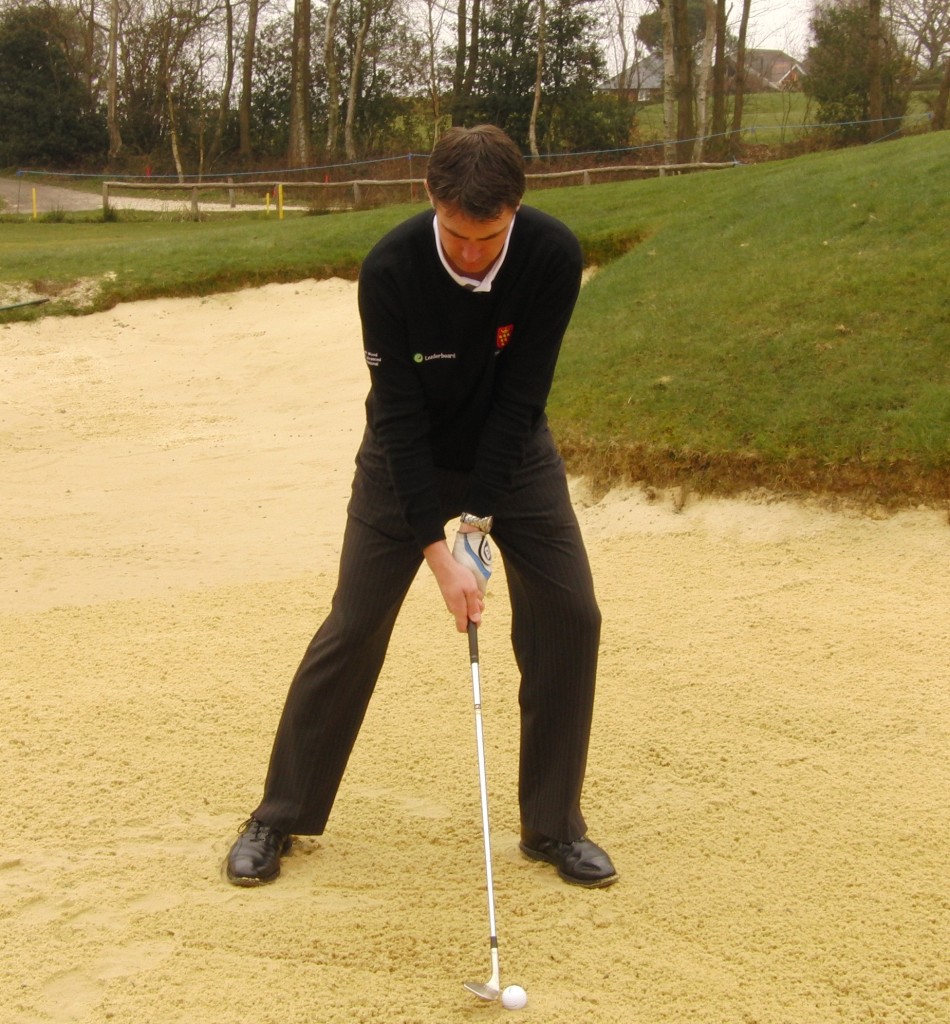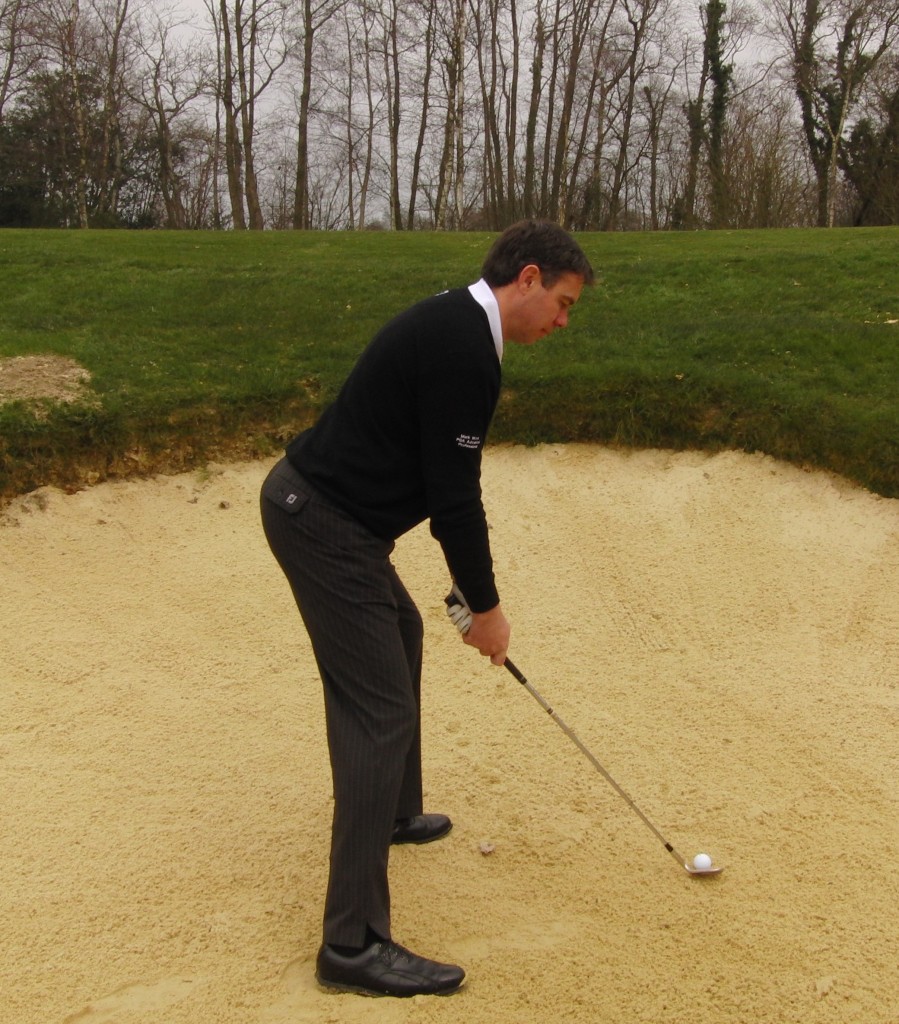Posts Tagged ‘Golf Lessons Kent’
Self Limitations
Limitations
When it comes to your golf do you have any personal limitations that stop you from achieving your goals of becoming a better player?
Many golfers put limits on how good they can become just by thinking in a negative way, for example “I knew I was going to miss that putt”, “I always play this hole badly” or “every time I have a good front 9 I always blow up on the back 9”
Sound familiar to you ???
Here is a young Ian Poulter just starting out his career on Tour. Did you know he turned professional off a 4 handicap and did his PGA training, working in a pro shop, doing a few club repairs etc….
If Ian Poulter had self-limitations, do you think he would be where he is now?
He is in the Top 20 in the world, Ryder Cup player, won on most major tours and has carved a great career so far. Ian had no self-limitations and he just followed the process of improving his golf every day. He knew where he wanted to be and he keep his mind strong, even today he is still improving and following his process…..
So when it comes to your golf, please don’t put limitations on how good you can be, how low you can get your handicap or put a bracket on your score. If you want to push your limitations and become a much better golfer you need to start lifting them away from your mind.
Book a lesson now and let’s start to lift your personal limitations away.
From Your Friends at Mark Wood Golf Academy
PS. Come down and tee it up to make some magic moments of your own. Check our website at
Mark Wood
PGA Advanced Professional
UK’s No1 Golf Coach
The Best Golf Lessons in Sussex and Kent
Best Ryder Cup Story of All Time!
Best Ryder Cup Story of All Time!
Considering the fierce competition of recent Ryder Cup matches, it is easy to forget that the bi-annual event was, until quite recently, a one-sided romp won by the American team time after time. You had to go back to 1957 to find a defeated US team. Between that occasion and the European victory in 1985, the closest the US came to losing was a historic battle played in September of 1969, on the seaside links at Royal Birkdale in Lancashire, England. That year, an Englishman had won their Open Championship for the first time in almost twenty years, and the British had high hopes for victory. More than 10,000 people crammed every sand dune and vantage point they could find around Birkdale’s 18th hole. The evening was gray and damp and the light was fading as the final twosome reached the tee. The result of the Ryder Cup was in the balance and rested squarely on the shoulders of these two men. One of them was the world’s greatest player, playing in his first Ryder Cup — the other was the reigning British Open Champion and his team’s leader. The entire competition had reached its dramatic focal point. The winner of this ultimate hole would secure victory for his country.
With the destination of the Ryder cup in question for the first time in many years, Tony Jacklin drove first. He had just holed a birdie putt on the 17th that he later described as, “One of the most important putts of my life.” It had enabled him to pull even with the great Jack Nicklaus. Both hit good tee shots down the short par five hole and strode down the red stone path toward the fairway. Jacklin was walking several yards ahead when Nicklaus called to him. Jacklin paused and allowed Nicklaus to catch up with him.
“How do you feel, Tony?” asked Nicklaus.
“Bloody awful!” replied Jacklin.
“I thought you might,” said Nicklaus, “but if it’s any consolation to you, so do I!”
Their eyes met briefly in mutual understanding of the pressure of the moment and the expectations of their respective countrymen. Then they walked to their balls. Nicklaus played first, his ball coming to rest in the heart of the green, some 30 feet from the flag. Jacklin responded with a bold shot over the left sandtrap but his ball bounded to the back of the green, some 40 feet away from the hole. After delivering standing ovations for both men as they approached their balls, the crowd fell into deathly silence. Supporters of both sides rubbed their eyes, gnawed on their knuckles and held their collective breath.
Jacklin’s putt for eagle was on line but came to rest some two feet short of the hole on the damp turf. Now Nicklaus putted boldly for the win, barely missing the hole but running some three or four feet by. The pressure was intense but Nicklaus, taking his time as usual, hunched over the ball in his familiar way and stroked it dead center into the cup. Jacklin was now faced with the longest two-foot putt of his life. If he made it, the Ryder cup was tied. If he missed it, he would be the scapegoat for the loss and would no doubt be crucified by the British sporting press, ever ready to turn on yesterday’s hero. Jacklin stepped towards his ball marker but, before he could replace his ball, Nicklaus bent down and picked up Jacklin’s marker, conceding the tying putt. As he extended his hand he said, “Tony, I’m sure you would have made it…but I wasn’t prepared to see you miss it.”
Their match was halved, the Ryder Cup was tied, and the US would retain the trophy. This fine gesture was typical of Nicklaus, demonstrating the highest qualities of sportsmanship and class we expect of all TRULY great champions.
From Your Friends at Mark Wood Golf Academy
PS. Come down and tee it up to make some magic moments of your own. Check our website at
Mark Wood
PGA Advanced Professional
UK’s No1 Golf Coach
The Best Golf Lessons in Sussex and Kent
The Plugged Lie
How to easily and effectively play a greenside plugged lie bunker shot
This shot is really simple to execute as long as you follow some early principals in the set up and swing movement.
In a normal greenside bunker shot we are using the bounce of the club (the back edge if you will) to play these particular shots from a normal sand lie. In a plugged lie situation we need to use the leading edge of the club a lot more to cut down deeper into the sand, creating a deeper divot. Using the bounce of the wedge will create a nice shallow divot.
So knowing we need to produce a deeper divot by using the leading edge of the wedge, we are going to use the most lofted wedge say 60 degree that has 8 degree of bounce. The trick here is to close the face slightly so that the leading edge becomes lower than the back edge. This now ensures that the leading edge digs into the sand first, not the bounce.
Hold the club in front of you with the leading edge facing up towards 12oclock and turn the face to 11.30oclock and then form your grip.
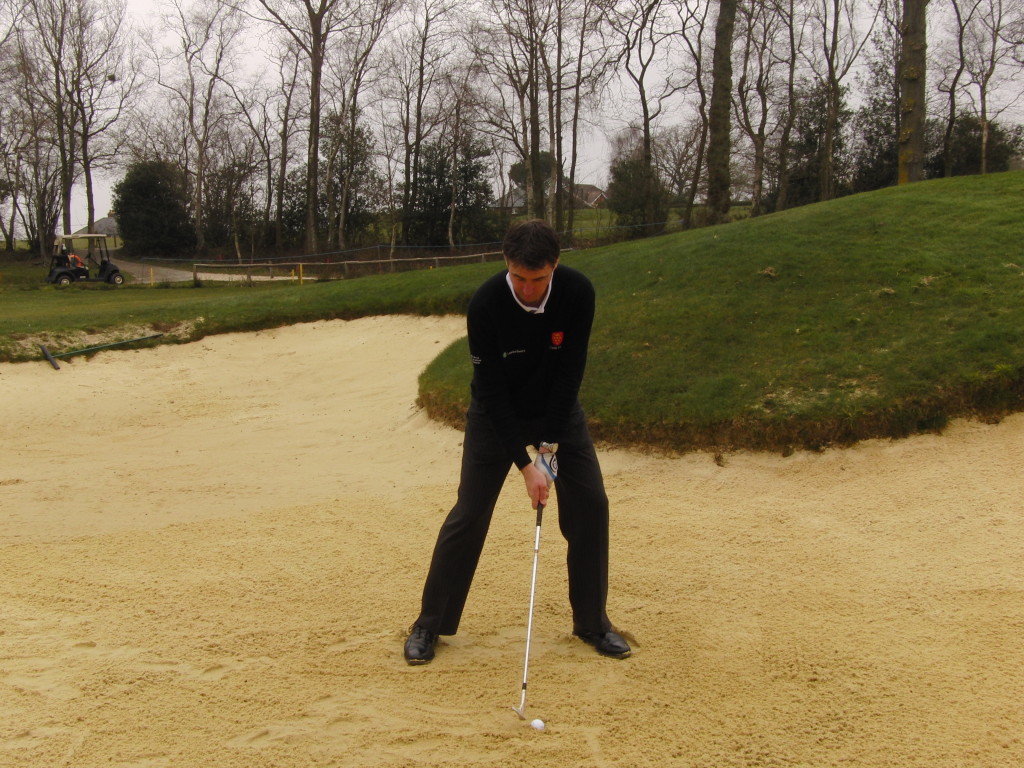
The stance is going to be slightly wider than normal for a regular bunker shot and you are going to keep the ball in the centre of the stance. The weight is still going to favour the left side (target side) as normal of at least 65%.
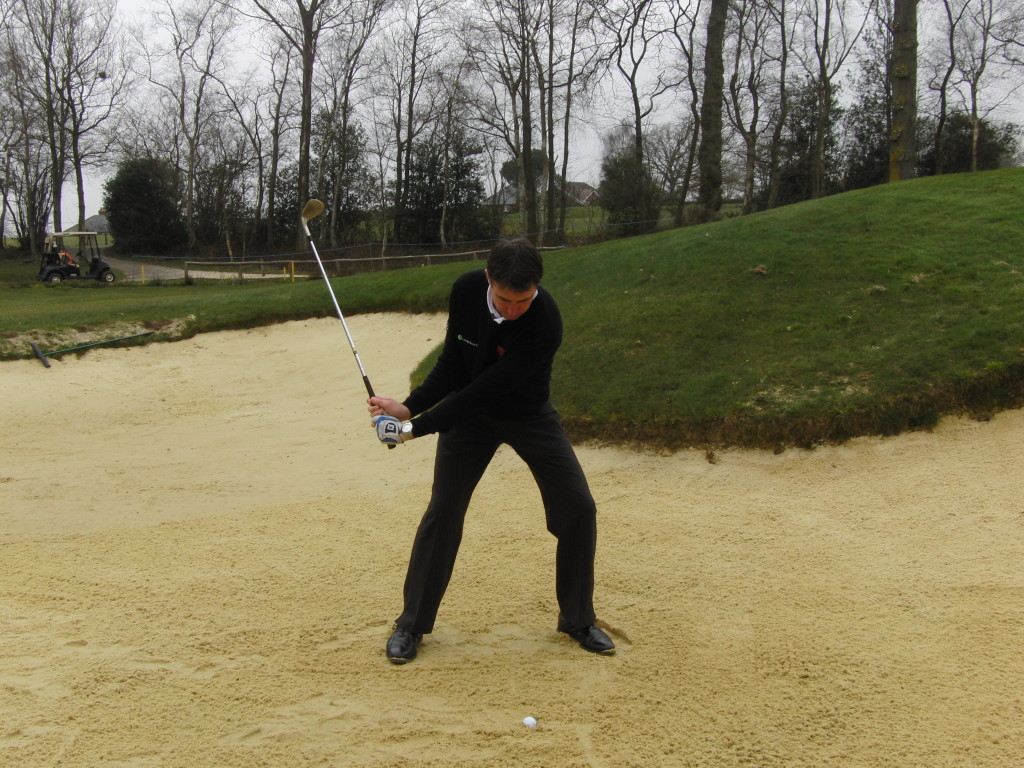
The trick in the swing is to get the wrists setting as quickly as possible in the backswing as we want to use this steep energy in the downward blow into the sand which is going to pop the ball up and out onto the green. We want to hit 1 – 2 inches behind the ball and allow for some run on the ball once it lands onto the green.
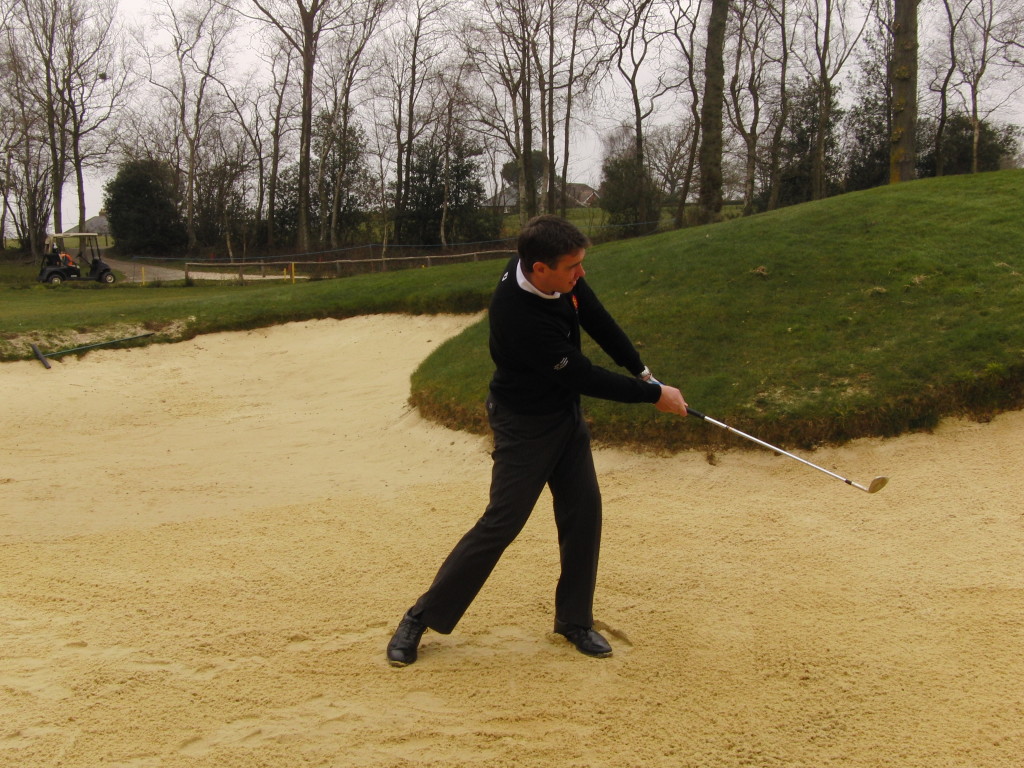
The swing is going to be very short in the follow through as a lot of the energy has be forced down into the sand to pop the ball up and out.
From Your Friends at Mark Wood Golf Academy
Check news and special offers on our website www.markwoodgolfacademy.co.uk
Mark Wood
PGA Advanced Professional
UK’s No1 Golf Coach
The Best Golf Lessons in Sussex and Kent
Top 10 Best Ever Caddie Quips
Top 10 Best Ever Caddie Quips
10. Golfer: “That can’t be my ball, it’s too old.”
Caddie: “It’s been a long time since we teed off, sir.”
9. Golfer: Caddie, how would you have played that last shot?
Caddie: ” Under an assumed name.”
8. Golfer: “This is the worst golf course I ever played.”
Caddie: “This isn’t the golf course, we left that over an hour ago, sir! ”
7. Golfer: “I’ve never played this badly before”
Caddie: “I didn’t realize that you had played before, sir”
6. Golfer: “Please stop checking your watch, it is annoying.”
Caddie: “This isn’t a watch, sir. It is a compass.”
5. Golfer: “I’ve played so poorly, I think I’m going to go drown myself in that lake.”
Caddie: “I don’t think you could keep your head down that long.”
4. Golfer: “I’d move heaven and earth to be able to break 100 ”
Caddie: “Try heaven, you’ve already moved most of the earth.
3. Golfer: Do you think it is a sin to play golf on Sunday?”
Caddie: “The way you play, Sir, its a crime any day of the week!”
2. Golfer: “Do you think I can get there with a 5-iron?”
Caddie: “Eventually.”
1. Golfer: You’ve got to be the worst caddy in the world!” he screamed.”
Caddie: “I doubt it. That would be too much of a coincidence.
Pass it on, make someone happy!
From Your Friends at Mark Wood Golf Academy
PS. Come on down and make some quotable swings of your own. Check news and special offers on our website www.markwoodgolfacademy.co.uk
Mark Wood
PGA Advanced Professional
UK’s No1 Golf Coach
The Best Golf Lessons in Sussex and Kent
The Bernard Langer Solution
The Bernard Langer Solution
Bernard Langer became one of the world’s best players and a two-time Masters champion by identifying his limiting factor and overcoming a problem few players in history have ever conquered. At a very early age he developed the putting “yips.” In a nutshell, that means he lost control of the muscles in his hands and arms when facing short putts. From three feet he might leave a putt short by 18 inches, then, on the very next green, be forced to watch in anguish as his unruly putter fired the ball 10 feet past the hole! Recognizing that this problem would prevent him permanently from reaching his goals, no matter how good his iron play, he spent hour upon hour, week after week, working to overcome his limitation. He took Gary Player as his model and, through determination and will power, he finally found a stroke that would work for him. For several years he was among the top players in European golf, then, without warning, the dreaded yips returned!
Once again he was compelled to go back to the practice putting green in search of a cure. Eventually he discovered a unique and creative grip that entails placing his left hand about ten inches down the shaft and letting the shaft rest against the inside of his left forearm. He then locks the grip of the club in place by gripping both the shaft and his left wrist with his right hand. While it may be one of the most unorthodox grips in history, it has enabled him to play competitive golf at the highest level once again.
Langer had the courage and determination not only to confront his weakness but to make it his strength. No one wins the Masters putting badly!
What’s your weakness?
Post it in the comments below.
From Your Friends at Mark Wood Golf Academy
P.S. The weather’s no joke, come out and make the most
of the sun!
Mark
PGA Advanced Professional
UK’s No1 Golf Coach
Mark Wood Golf Academy
The Best Golf Lessons in Sussex
Sam Snead
Is This Best Golf Joke Ever?
I don’t know but I can just picture “Slaming Sam” delivering the lines with that hillbilly drawl and a
glint in his eye!
A number of years after he retired, Sam Snead was playing a round of golf with a young would- be
Tour player. As they were waiting at the tee box on the first hole, Sam’s opponent — who was rather
large and strong — asked Sam’s advice about the upcoming tee shot. “Mr. Snead, do you think I can
clear those tall pine trees over on the right?”
Sam thought for a moment and replied, “When I was your
age, I could clear those trees with no problem.”
The young man, brimming with confidence, teed up his
ball, took a few practice swings, and promptly whacked
his ball right into the middle of the pine grove. He looked
at Sam, quizzically and disgustedly threw his driver back
into the bag as Sam coolly remarked, “Of course, when I
was your age, those trees were only eight feet tall!”
Think you have a better golf joke?
Post it in the comments below.
From Your Friends at Mark Wood Golf Academy
P.S. The weather’s no joke, come out and make the most
of the sun!
Mark
PGA Advanced Professional
UK’s No1 Golf Coach
Mark Wood Golf Academy
The Best Golf Lessons in Sussex
The Laws of Golf
The laws of golf
LAW 1: No matter how bad your last shot was, the worst is yet to come. This law does not expire on the 18th hole, since it has the supernatural tendency to extend over the course of a tournament, a summer and, eventually, a lifetime.
LAW 2: Your best round of golf will be followed almost immediately by your worst round ever. The probability of the latter increases with the number of people you tell about the former.
LAW 3: Brand new golf balls are water-magnetic. Though this cannot be proven in the lab, it is a known fact that the more expensive the golf ball, the greater its attraction to water.
LAW 4: Golf balls never bounce off of trees back into play. If one does, the tree is breaking a law of the universe and should be cut down.
LAW 5: No matter what causes a golfer to muff a shot, all his playing partners must solemnly chant “You looked up,” or invoke the wrath of the universe.
LAW 6: The higher a golfer’s handicap, the more qualified he deems himself as an instructor.
LAW 7: Every par-three hole in the world has a secret desire to humiliate golfers. The shorter the hole, the greater its desire.
LAW 8: Topping a 3-iron is the most painful torture known to man.
LAW 9: Palm trees eat golf balls.
LAW 10: Sand is alive. If it isn’t, how do you explain the way it works against you?
LAW 11: Golf carts always run out of juice at the farthest point from the clubhouse.
LAW 12: A golfer hitting into your group will always be bigger than anyone in your group. Likewise, a group you accidentally hit into will consist of a football player, a professional wrestler, a convicted murderer and an IRS agent — or some similar combination.
LAW 13: All 3-woods are demon-possessed.
LAW 14: Golf balls from the same “sleeve” tend to follow one another, particularly out of bounds or into the water (See Law three).
LAW 15: A severe slice is a thing of awesome power and beauty.
LAW 16: “Nice lag” can usually be translated to “lousy putt.” Similarly, “tough break” can usually be translated “way to miss an easy one, sucker.”
LAW 17: The person you would most hate to lose to will always be the one who beats you.
LAW 18: The last three holes of a round will automatically adjust your score to what it really should be.
LAW 19: Golf should be given up at least twice per month.
LAW 20: All vows taken on a golf course shall be valid only until the sunset.
Mark
PGA Advanced Professional
UK’s No1 Golf Coach
Mark Wood Golf Academy
The Best Golf Lessons in Sussex
Define the Problem
Define the problem
The first step in championship problem solving is to make sure you determine the exact nature of your problem. Many a tournament has been lost by the player who attempts an impossible shot from the rough in the vain hope of making birdie where bogey will win the day. The six or seven he winds up making takes him right out of contention. Precisely defining the problem is an art in itself.
Golf teacher Tommy Armour, author of the timeless masterpiece of instruction, How to play your best golf all the time, was a master at finding a player’s problem and no one was better at accurately defining it. One day a club member approached him to schedule a lesson.
“What seems to be your problem?” questioned Armour.
“I can’t get backspin on my long-iron shots, like the pros do,” he said.
“How far do you hit your 3-iron?” asked Armour
“About 175 yards,” replied the member.
“Then why on earth would you want to put backspin on the ball?” asked Armour.
What’s your problem?
Is it lack of consistency, distance, three putting or you just want to improve but not sure how to?
Let me help you!
So stop focusing on back spin and move your golf game forward…
book a lesson now http://www.markwoodgolfacademy.co.uk/booking/ or call 07796 271661
I hope you enjoyed the article, any comments or Questions then please leave a comment below..
Until next time I wish you all the golfing success
Mark
Mark Wood Golf Academy
Dale Hill hotel & golf club
East Sussex
The UK’s No1 Golf Coach where it counts – Results!
Five effective ways to improve the quality of your practice part one by Andrew Wood
Five effective ways to improve the quality of your practice part one
Playing round after round, without intervening practice sessions, does little to improve your game. You may have a few real life experiences that prove you should have taken a penalty shot and dropped out of trouble, instead of hitting it deeper into the woods, but that’s learning the hard way. Here are five keys to quickly and dramatically improving your performance in your game, your business and your personal life.
1. Record, shoot video or take notes
Keep a record of your actions and the results they produce for you. By recording your performance, on videotape if you are golfing, or by using audiotape or notes if you are at work, you can start to look for helpful or harmful patterns.
- How many putts a round do you average?
- Do you hit all your drives in the right rough or are most of your bad shots pulled?
- What percentage of prospects do you close?
This type of self-evaluation will indicate clearly to you the areas most urgently in need of improvement? As you collect this valuable information, continue to take notes, writing down both the problem and solution. Chart your progress and monitor your results frequently, even daily.
In the heat of battle, it is amazing how even the most proficient among us tends to forget the simplest of fundamentals, like keeping our heads still, taking the clubhead away slowly or remembering to ask for a sale. Brief notes in a diary, on scraps of paper or even on table napkins have provided a written reminder of a key fundamental and resulted in victory in many a tournament. For some champions the secret is contained in a single word or phrase taped inside their locker door.
When Britain’s Tony Jacklin arrived at his locker on the final day of the 1970 US Open Championship, he found his good friend Tom Weiskopf had taped a message to the door. The message was short and sweet. There were only two words. “Tempo, Jacko.”
Now who would have thought the reigning British Open Champion, a man going into the final round with one of the biggest leads in US Open history, would need such basic advice. As it happened, Jacklin gave much of the credit for his victory to those two little words. The difficult Hazeltine National course made some of the big name players of the day pay a severe toll. Dave Hill, who finished second, said, “All this course lacks is 80 acres of corn and some cows.” Well, in spite of Hill’s lack of affection for the venue, Jacklin maintained that smooth tempo and became the first Briton to win the US Open since Ted Ray in 1920, and by seven shots, the second largest margin in history. Weiskopf’s little reminder helped him achieve his victory.
As you know, we may not always need to be told, but we do need to be reminded from time to time.
I hope you enjoyed the article, any comments or Questions then please leave a comment below..
Until next time I wish you all the golfing success
Mark
Mark Wood Golf Academy
Dale Hill hotel & golf club
East Sussex
The Greenside Bunker Shot Set Up
The Greenside Bunker Shot Set Up
When setting up to play a regular greenside bunker shot there are a few important things to get right as this will go a long way in helping you to execute the shot.
Firstly I want to briefly describe the bounce of the club and what it does. The bounce of the wedge is there to help you and it will guide through the sand if used correctly.
As the bunkers have become better over the last few years, with the quality of the sand and drainage, manufactures have improved there wedges with varying degrees of loft’s and bounce angles. With this in mind you have all the correct tools to be playing this shot well. The only thing that is still “old school” is the way golfers set up to these shots, so I am going to explain the modern way of escaping the sand with ease.
“If the leading edge digs in, poor bunker shots will be the result. Remember the bounce of the wedge is your friend, so please use it”
Open the clubface a little as this will help encourage you to use the bounce of the wedge. Grip the club after you have opened the clubface a little and use your normal neutral grip.
Take a nice wide stance a wriggle your feet into the sand a little as this helps you to feel the texture of the sand with your feet. It also lowers your centre of gravity ensuring sand is struck from under the ball.
Keep at least 70 percent of your weight on the left side as I want you to turn around your left side in the swing. Setting your weight forwards also helps create a consistent strike pattern in the sand. The feeling here is that you are braced into the left side.
Keep the ball position forward in the stance, just inside the left heel as this will help create a consistent strike pattern in the sand, forget the old cliché of looking 2 inches behind the ball as this set up will promote the strike pattern required, one less thing to worry about!!
The shaft angle should be leaning back just behind the ball as this will ensure the bounce of the wedge is being used. If you lean the shaft forwards you will start to dig in too much with the leading edge creating poor quality bunker shots.
Keep the body alignment parallel to the target line as this will encourage you to swing the club down the target line and not across it, promoting pure backspin and not slice side spin.
Keep your posture angles nice and engaged as stranding slumped is a sure way to hit bad shots!!
I also like to feel that I am stretching out towards the ball a little with my arms as this lowers the shaft a little and helps create the soft swing arc required to play these shots well.
I hope you enjoyed the article, any comments or Questions then please leave a comment below..
Until next time I wish you all the golfing success
Mark
Mark Wood Golf Academy
Dale Hill hotel & golf club
East Sussex




